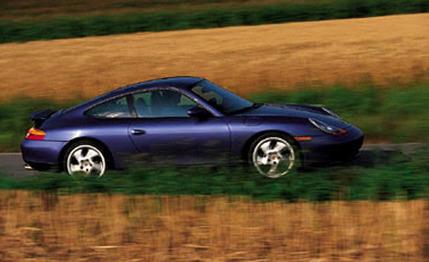 Long-Term Road Test
Long-Term Road Test
We could provide the usual justifications for subjecting this latest-generation Porsche 911 Carrera to our none-too-kind ministrations for 40,000 miles. The '99 model was, after all, the first 911 powered by a water-cooled flat-six. It was also the first 911 with completely new sheetmetal since, well, since the car's introduction at the 1963 Frankfurt auto show.
But who's kidding whom? When did we ever feel the need to justify driving a Porsche-any Porsche-let alone holding on to one for 40,000 miles? Even before these spanking-new '99 models hit the dealerships, we had our order in.
Only coupes, with a base price of $67,463, were available in this generation's first year. We ordered ours with the optional Zenith Blue Metallic paint ($805) and full leather interior in Graphite Grey ($3215). We also specified traction control ($1215), the 18-inch "Turbo-Look" aluminum wheels, which came with 225/40 front and 265/35 rear Continental ContiSportContact tires ($1190 for the set), the 10-speaker Digital Sound package ($1175) to enhance the CD-player-equipped audio system ($345), and the trip computer ($275). Since we weren't actually paying the tab, we selected a few "exclusive" options, including the carbon-fiber shift knob and hand-brake handle ($880), stainless-steel exhaust pipes ($747), the stainless-steel door sill with insignia ($415), and floor mats with Porsche lettering ($110). The grand total, including freight and luxury taxes, came to $78,457.
Our car arrived in April 1999, just in time to miss the saline puddle baths and treacherous traction patches of winter. The 911 was perfect, other than a loose knob on the radio. Due to the tenuous connection between the knob and its shaft, we had trouble selecting stations, which did nothing to help our relationship with the sound system's inscrutable controls. A new knob took a month to arrive, costing us $12 and constituting the car's only unscheduled stop.
The fact is that the controls on the Porsche CR-220 sound system are not intuitive, but they make some sense after you spend time with the owner's manual (as opposed to some controls we've encountered that are hopeless, even when their function is thoroughly understood). Without some indoctrination, the functions of the radio's 18 buttons and two knobs are destined to remain forever mysterious, as was the loading slot for the CD player, hidden behind the radio's fold-down faceplate. Some drivers were flustered because the instructions explaining the radio's operation were in a leather pouch tucked into a rack below the steering column. This location was dictated by the absence of any reasonably sized stowage compartment inside the car.
After the 911's left-rear wheel was chewed up at our favorite local automated scrubbery, we learned to be very careful before committing the car to a drive-through wash. Turns out the convex contour of the spokes causes them to protrude beyond the tire sidewall, and they hit the rails that guide the car through the spinning brushes. Wheel Enhancement, the Porsche wheel emporium in Culver City, California, provided us with a replacement for $300.
The most rigid Porschephiles look upon automatic carwashes as desecration, but for the daily drivers here, regular washings are a necessity. Fact is, a better wheel design-one with more recessed spokes and a band of protective rubber on the tire-is in order.
As that first summer progressed, our 911 got plenty of exercise. If you hold that entering freeways is made easier when merging at a speed higher than the flow of traffic, you'll find much to appreciate in the 911, which can reach 100 mph from a dead stop in about 12 seconds.